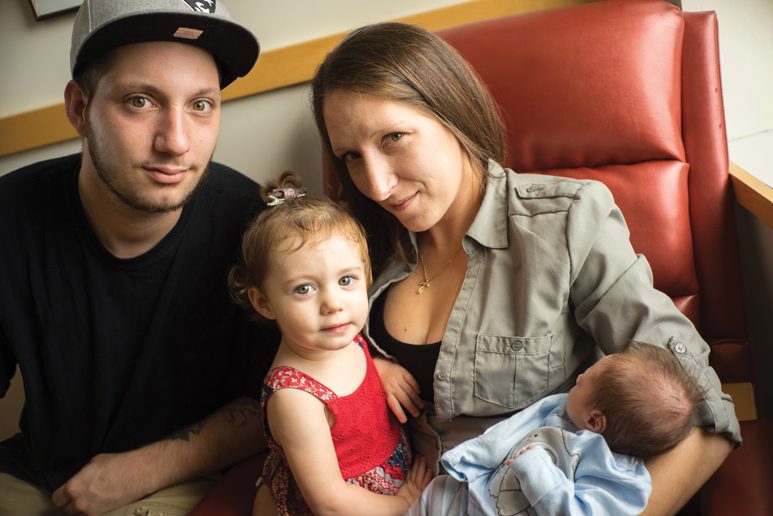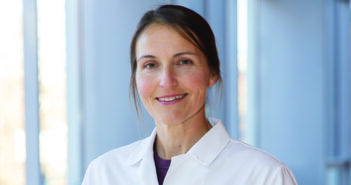As more and more infants are born dependent on opioids, hospitals and researchers are working together to chart the best path to recovery.
Caitlyn O’Brien has been here before. That doesn’t make it any easier.
It’s mid-August, and the slim 29-year-old is eight months pregnant with her third child, and first son. She shifts uncomfortably in a floral-patterned chair at Women & Infants Hospital, her partner, Perry Fedorak, 26, by her side. They’re preparing, for the second time, to bring a baby into the world dependent on opioids.
“I’m scared,” O’Brien says. “It sucks that he has to go through this for the decisions I made.”
The medical director of the Newborn Nursery, Adam Czynski, DO, has a different take.
“It would be worse if you weren’t taking medication,” he says, referring to the methadone O’Brien needs to recover from an addiction to Percocet. If she’d detoxed, he says, she could have gone into withdrawal. “You’d be at risk of delivering preterm. Any parental stress can be bad,” Czynski says. “You’re making sure that his home is perfect.”
But when he’s born on August 25, after 38 weeks of daily methadone, Bentley Fedorak will go cold turkey. Then they’ll wait for signs of withdrawal, such as fever, diarrhea, or tremors. The constellation of symptoms indicates neonatal abstinence syndrome (NAS), and it extends an infant’s hospital stay by days or weeks as clinicians assess the severity of the withdrawal and administer an opioid—usually morphine or methadone—to ease the symptoms and wean the newborn off the drug.
“His body is making changes based on hormones and chemicals he’s seen,” Czynski tells the anxious couple. “Then when he’s born, we’ll tweak it. We’ll slowly let him readapt back.”
O’Brien and Fedorak saw this firsthand in January 2015, when their daughter, Hailie, was born. She stayed at Women & Infants for two weeks as doctors helped her taper off the opioids in her bloodstream.
“That was the hardest thing when I had Hailie, when my dad asked, why are you still here?” O’Brien says. “It felt like forever.”
But she says it helped that Hailie is participating in a longitudinal study at Brown and Women & Infants, which O’Brien and Fedorak are doing again with their son. Though children have been born dependent on opioids for years, no one agrees on the best way to wean them off, so every hospital that treats NAS babies has its own standard of care. The trial now underway is assessing treatment strategies and long-term effects, an attempt to define a no man’s land of personal experience, observational studies, and anecdotal evidence.
“If we can be of assistance to other people, if I could save someone else from going through the unknown, help find the best way to make sure the baby’s comfortable, the mother’s comfortable…” O’Brien trails off.
“Nobody wants their child to have to go through this.”
Old Problem, New Face
The escalating opioid epidemic has claimed millions of victims. In 2014, the Substance Abuse and Mental Health Services Administration reports, there were 1.9 million people in the US with a substance use disorder involving prescription pain relievers, and nearly another 600,000 involving heroin. Hundreds of thousands more use an opioid replacement therapy, such as methadone or buprenorphine, to treat their dependence.
The sheer scale of the tragedy has done much to raise awareness about the disease of addiction, and that it can happen to anyone. That includes pregnant women. The rate of babies born in the US with neonatal abstinence syndrome has skyrocketed along with opioid use: from 2000 to 2012 it nearly quintupled, to 5.8 per 1,000 hospital births. According to a 2015 analysis in the Journal of Perinatology, that’s 21,732 infants diagnosed with opioid withdrawal every year.
It’s a distinctly regional issue: in New England, the NAS birth rate is 13.7 per 1,000, while in the Pacific states it’s 3.0. “This is the only place I’ve encountered with a specific NAS unit in the nursery,” instead of in the NICU, says Czynski, an assistant professor of pediatrics at Alpert Medical School who moved to Rhode Island from southern California in March. “In California, it’s all methamphetamines,” he says. “Here, everything’s opioids, opioids, opioids.”
Thirty years ago, it was cocaine. Barry Lester, PhD, professor of psychiatry and human behavior and of pediatrics at Alpert Medical School, has been studying the effects of drug use during pregnancy for decades. Babies exposed to cocaine in utero are born with the drug in their system, and right away they may have a high-pitched cry, tremors, and other symptoms that look like mild opioid withdrawal; as the newborn metabolizes the cocaine, the symptoms go away.
But how did cocaine affect these children long term? Many people—doctors, lawmakers, the general public—were sure they suffered developmentally for it. “People didn’t understand the consequences of prenatal cocaine exposure,” Lester says. “There was a knee-jerk reaction: cocaine equals inadequate mother equals take the infant away and put it in foster care.”
From 1993 to 2011 Lester ran the NIH Maternal Lifestyle Study, which followed almost 1,400 kids nationwide to document the long-term effects of prenatal cocaine exposure. Their findings suggested that poverty and other chronic stresses, not just prenatal drug exposure, adversely affected those children’s behavior, educational achievement, and other factors.
“There was so much hatred and anger in this country against these women using drugs, which has improved, I have to say,” Lester says. “Research has shown that addiction is a disease of the brain. … This is not about women willfully doing harm to their babies. It has helped dispel myths and deep-seated prejudices and shift policy from punitive to treatment approaches.”
What is Best?
Around the time Lester began recruiting for the Maternal Lifestyle Study, neonatologist Mara Coyle MD’86, P’15ScM’16 became the director of the level II nursery at St. Luke’s Hospital in New Bedford, MA. Right away Coyle was caring for patients with NAS, whose mothers had taken heroin or methadone. “Prescription opiates were not an issue yet,” she says. Twenty years later, “the face of opioid dependence has changed”—and so has treatment.
NAS is related to exposure in the latter stages of pregnancy; what opioid a woman is taking at that time—street drugs, replacement therapy like methadone or buprenorphine, or a prescription—will impact the degree to which the newborn will experience withdrawal.
But there’s no recognized standard of care for NAS treatment, leaving hospitals to figure it out on their own. Most use morphine or methadone; diluted tincture of opium (DTO) has fallen out of favor. Some administer sedatives like phenobarbital or clonidine to reduce opioid dosage. How much medication infants receive, and for how long, depends on the results of a scoring system that attempts to quantify NAS symptoms to standardize treatment, yet which every hospital interprets differently.
“It’s not because there’s been an absence of research,” Coyle says of the varied approaches. “There have been dozens of studies attempting to define which is the best treatment strategy for a standard of care. But what is ‘best’? Cut the length of stay? You can quantify that. Or is it long-term outcome? We don’t have the information, we don’t have good follow-up data, which ultimately is the more important issue.”
Coyle, a professor of pediatrics (clinical) at Alpert Medical School, who considers Lester a mentor, has published numerous papers since the early 2000s on treatment strategies for moms and babies and their effect on the newborns’ symptoms and length of hospital stay. For the double-blind, multisite MOTHER study, published in the New England Journal of Medicine in 2010, Coyle e valuated neonatal outcomes for exposure to buprenorphine and methadone, the more widely recommended treatment. In an earlier trial, in Pediatrics, she investigated whether phenobarbital alleviated NAS symptoms.
“I don’t think newborn treatment should be one-stop shopping,” Coyle says. “It’s not the exact same dosing strategy for each patient, because they have different levels of dependence.” She found that giving babies phenobarbital helped wean them off opioids, and go home, sooner. Meanwhile the MOTHER trial showed that infants who had been exposed to buprenorphine needed less morphine and the duration of treatment was shorter than those exposed to methadone.
“That’s important information [for mothers]to have,” says Coyle, who now sees patients at Women & Infants. “But they’re not the same drugs. … Buprenorphine has a ceiling of effect, meaning more drug doesn’t mean more opioid effect, so if you’re seriously addicted you may not be a candidate for buprenorphine because you could go into immediate withdrawal. So it’s not a replacement for methadone.”
A key part of Coyle’s work is prenatal consultation, to counter misinformation about replacement therapy and NAS. Most women don’t want to be on any drug when they find out they’re pregnant, she says; they want to quit then and there. “They don’t want their baby to go through withdrawal,” Coyle says. While some recreational users may be able to quit, she says the majority will relapse, which is why she recommends replacement therapy; piling the agony of detox onto the normal discomforts of pregnancy is simply unrealistic for most women.
“The first thing I tell a patient is congratulations for being in treatment. It’s far better to be in treatment than to be using,” Coyle says. As for NAS, she tells moms, “It’s a medical condition, it’s short lived, and we’re going to help your baby get through that.”
Coyle focuses on the certainties of NAS during prenatal consults: withdrawal symptoms, how they’re assessed and treated, how long treatment might take, the benefits of breastfeeding. While opiate-exposed newborns have a greater incidence of complications, like low birth weight and respiratory problems, she says she doesn’t discuss these because not all babies will experience every problem.
A 2015 retrospective study in the Journal of Perinatology that Coyle co-authored with developmental pediatrician Jo-Ann Bier, MD RES’88 F’90, an assistant professor of pediatrics at Harvard Medical School, noted smaller head circumferences and lower motor skill development among infants exposed to high doses of maternal methadone. “This shouldn’t be interpreted as causal, but merely an observation of a select group of opiate-exposed newborns,” Coyle wrote in an email. “A prospective blinded study to specifically look at these outcomes would better confirm these findings.”
The need for such research is critical, Lester says. “There are no studies in the literature of the long-term developmental outcome of babies who went through NAS. Period,” he says. “One of my PowerPoint slides says, ‘Summary of outcome studies for NAS kids,’ and there’s nothing on the slide.”




